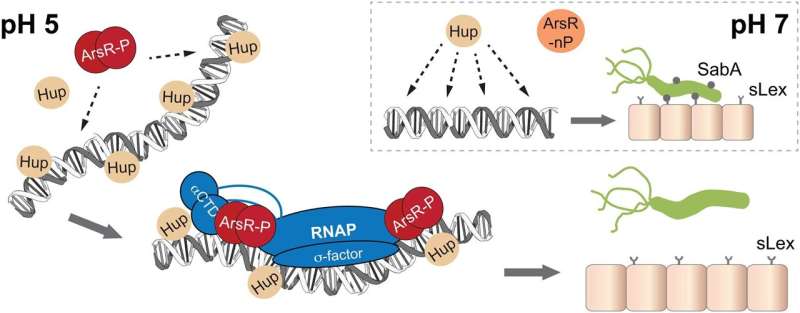This article has been reviewed according to Science X's editorial process and policies. Editors have highlighted the following attributes while ensuring the content's credibility:
fact-checked
trusted source
proofread
Study reveals how ulcer bacteria's ability to attach to inflamed stomach is affected by pH

A study by Anna Arnqvist's research group at Umeå University reveals molecular details about the gastric pathogen Helicobacter pylori's ability to bind to an inflamed stomach and how this is controlled by the stomach's pH. An increased understanding of how H. pylori bacteria can cause a persistent lifelong infection is an important piece of the puzzle in order to ultimately identify the characteristics that contribute to disease.
When the stomach becomes infected with the gastric pathogen Helicobacter pylori, the infection lasts for life if it is left untreated. The infection can cause peptic ulcer disease as well as stomach cancer. The environment within the stomach undergoes continuous changes, requiring the bacteria to adapt by adjusting the expression of certain proteins based on the prevailing conditions.
It is commonly assumed that the stomach has a low pH. However, the pH levels vary significantly, ranging from the highly acidic environment in the stomach lumen to largely neutral conditions at the outermost layer of the stomach epithelial cells, which is protected by a mucus layer. It is in the mucus layer or tightly attached to the outermost cell layer that most H. pylori bacteria are found. The expression of many genes is regulated in response to pH, causing the bacterium to produce varying amounts of proteins depending on the pH of its surroundings.
H. pylori has adherence proteins, so called adhesins, on their surface that are used for attachment to the mucus layer or on the outermost cell layer. The SabA protein is one such adhesin, which enables the bacterium to adhere to inflamed gastric mucosa.
In this study, published in Nucleic Acids Research, Arnqvist's research group has, on molecular level, elucidated how pH affects the production of the SabA protein. At low pH, the regulatory protein ArsR becomes phosphorylated and forms a complex. The study has revealed the two binding sites of the ArsR complex and highlights the importance of DNA topology for ArsR-binding.
Furthermore, the study identifies the primary ArsR-binding site to which the ArsR protein complex binds for pH-regulation. The research also demonstrates that variations in a specific DNA region among different H. pylori strains affects pH-regulated SabA expression.
A significant challenge encountered in this project has been implementing genetic modifications in H. pylori. The process was technically challenging and time-consuming due to the complexity of obtaining the correct DNA constructions. Initially, we attempted to outsource the design to an internationally reputable company, but after four month and many trials, they returned the assignment incomplete.
"Navigating through this has demanded considerable patience," says Anna Åberg, staff scientist who finally succeeded with the demanding constructions.
H. pylori typically colonize the lower part of the stomach, where the pH is slightly higher compared to the middle part, which contains more acid-producing cells, resulting in lower pH. It has long been recognized that infections in the middle part of the stomach (corpus) pose a risk factor for cancer development.
A deeper knowledge of how pH influences fundamental properties, such as H. pylori adhesion to gastric mucosa, lays the groundwork for a better understanding which H. pylori characteristic's that are more likely to contribute to disease development.
More information: Anna Åberg et al, Molecular insights into the fine-tuning of pH-dependent ArsR-mediated regulation of the SabA adhesin in Helicobacter pylori, Nucleic Acids Research (2024). DOI: 10.1093/nar/gkae188





















